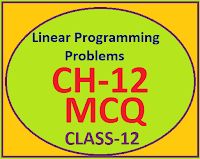Q 4) Objective function of a L.P.P. is
a) Constraint
b) A function to be optimized
c) A relation between the variables.
d) None of these.
Q 5) Which of the following terms is not used in a linear programming problems
a) Slack variable
b) Objective function
c) Convex region
d) Feasible region
Ans: d
Q 6) The point which does not lie in half plane 2x + 3y – 12 < 0 is
a) (1, 2)
b) (2, 1)
c) (2, 3)
d) (-3, 2)
Ans: c
Q 7) Z = 7x + y, subject to 5x + y ≥ 5, x + y ≥ 3, x ≥ 0, y ≥ 0. The minimum value of Z occurs at
(a) (3, 0)
(b) (5, 6)
(c) (7, 0)
(d) (0, 5)
Ans: d
Q 8) The corner points of the feasible region determined by the following system of linear inequalities:
2x + y ≤ 10, x + 3y ≤ 15, x, y ≥ 0 are (0, 0), (5, 0), (3, 4) and (0, 5)
Let Z = px + qy, where p, q > 0. Conditions on p and q so that the maximum of Z occurs at both (3, 4) and (0, 5) is
a) p = 3q
b) p = 2q
c) p = q
d) q = 3p
Ans: d
Q 9) Z = 8x + 10y, subject to 2x + y ≥ 1, 2x + 3y ≥ 15, y ≥ 2, x ≥ 0, y ≥ 0. The minimum value of Z occurs at
(a) (4.5, 2)
(b) (1.5, 4)
(c) (0, 7)
(d) (7, 0)
Ans: b
Q 10) The corner points of the feasible region determined by the system of linear constraints are (0, 10), (5, 5), (15, 15), (0, 20). Let Z = px + qy, where p, q > 0. Condition on p and q so that the maximum of z occurs at both the points (15, 15), and (0, 20) is
a) p = q
b) p = 2q
c) q = 2p
d) q = 3p
Ans: d
Q 11) The solution set of the inequation 2x + y > 5 is
a) Half plane that contains the origin.
b) Open half plan not containing the origin.
c) Whole xy-plane except the point lying on the line 2x + y = 5
d) None of these
Ans: b
Q 12) The maximum value of f(x) = 4x + 3y subject to constraints x ≥ 0, y ≥ 0, 2x + 3y ≤ 18; x + y ≥ 10 is
(a) 35
(b) 36
(c) 34
(d) none of these
Ans: d
Q 13) Which of the following statement is true
a) Every L.P.P. admits an optimal solution
b) An L.P.P admits a unique solution
c) If an L.P.P admits two optimal solutions, then it has an infinite number of optimal solutions.
d) An L.P.P admits only two optimal solution
Ans: c
Q 14) Objective function of a L.P.P.is
(a) a constant
(b) a function to be optimized
(c) a relation between the variables
(d) none of these
Ans: b
Q 15) Objective function of a L.P.P is
a) a constant
b) a function to be optimized
c) a relation between the variable
d) None of these
Ans: b









